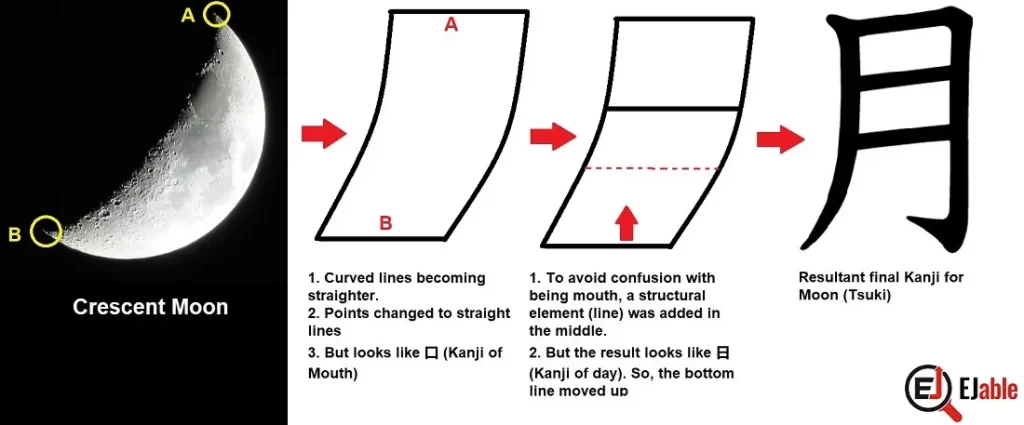Kanji of Moon and Month: 月 (Tsuki or Getsu/Gatsu)

The kanji for “moon” in Japanese is 月.
Please note that the original Japanese calendar, like some others in Asia, was the lunar calendar, based on the moon’s movement, so the moon in Japanese 月 also is also the kanji for “month.”
The pronunciation of the Kanji 月 is “tsuki” (つき) in its kun’yomi (Japanese reading) and “gatsu” (ガツ) or “getsu” (ゲツ) in its on’yomi (Chinese reading). The shape of this kanji is rather simple, and its shape has a clear origin.
Moon’s Kanji 月 is constructed with 4 strokes. This Kanji is a part of the JLPT N5 syllabus (please check the list of JLPT N5 Kanji). In Japanese schools, this Kanji is taught in grade 1.
Origin of Moon’s Kanji 月
In its original form, the moon in Japanese was a pictograph of a crescent moon, with the two protruding “horns” on either side of the character representing the points of the crescent and the center line depicting the dark part of the moon. Over time, this pictograph was stylized and simplified into its modern form 月.
Please refer to the following image to see how the moon’s kanji evolved as it appeared in Oracle Bone Script, Bronze inscription, small seal script, and how we write it in the present:

Mnemonic: How to Remember the Kanji of Moon or Month (月)
To remember the kanji of the moon 月, you could picture it as a simplified, stylized drawing of a crescent moon, with the two outer lines (on the left and right) representing the visible part of the crescent moon as it appears in the sky.
Some people mention that the middle line can be seen as a separation between the dark and light parts of the moon, adding depth to the crescent shape. However, this explanation seems confusing because, in such a case, the middle line has to be vertical and not horizontal.
The following picture visually represents the origin and an effective way to remember the kanji of Tsuki, i.e., moon:

Explanation for the Shape of Moon’s Kanji 月:
- The leftmost picture is of a crescent moon.
- Now, as mentioned in the section “Important Points While Learning Kanji” in our article about remembering Kanji, the left and right-hand side outer lines become straighter in the Kanji. Similarly, points “A” and “B” are stretched into straight horizontal lines. With these, we get the first shape of the Kanji for the Moon, as shown in the second picture from the left.
- However, this shape can easily be confused with the Kanji of Mouth or opening (Guchi), which is 口. To avoid we add a structural element in the form of a horizontal line in the middle. Please note that such structural elements do not carry any meaning. Such elements are often there to create a better balance in the shape of a Kanji. The resultant shape is in the third shape from the left in the above picture.
- However, the resultant shape is similar to 日, which is the Kanji for ‘Day’ or ‘Sun’. To avoid any confusion, we move the bottom horizontal line slightly upward. This gives us the Kanji for ‘Moon’ or Tsuki, as shown in the rightmost shape in the above picture.
Stroke Order for the Kanji 月
The following illustrations show the stroke order to write the Kanji 月, or “moon” in Japanese:


Additional Facts about Moon’s Kanji 月 (Tsuki)
Please note that when 月 appears as a Kanji radical on the left side of a kanji, it often takes on a different form and meaning, representing “flesh” or “body part” rather than “moon.” In such cases, it is also a variant of the radical 肉 (niku), meaning “meat” or “flesh.” However, these radicals have completely different meanings. So, even though, at times, the radical for niku is written as ⺼it’s essential to distinguish the shapes.
Examples of 月 as a Radical representing Flash or Body Part
When the kanji shape 月, commonly known for “moon,” appears as a radical in kanji related to body parts or flesh, it does not represent the moon. In these contexts, 月 is a symbol for flesh or body parts, and it’s often called “にくづき” (nikuzuki) in Japanese, meaning “meat radical.”
This usage stems from the fact that in ancient Chinese script, the symbol for “flesh” resembled the symbol for “moon,” and over time, they came to be written the same way. So, while 月 means “moon” when it stands alone as a kanji, as a radical in certain kanji, it takes on a different meaning related to the body.
This dual meaning of the radical 月 is an interesting aspect of kanji, where the context determines the meaning. It highlights the evolution and complexity of the writing system, where a single shape can convey different meanings based on its usage.
Some examples of Kanji characters with this radical are as follows:
- 胃 (い, i): Stomach.
- 背 (せい, sei): Back, height.
- 胸 (むね, mune): Chest, breast.
- 肝 (かん, kan): Liver.
- 肺 (はい, hai): Lung.
- 肌 (はだ, hada): Skin.
- 脳 (のう, nō): Brain.
- 腸 (ちょう, chō): Intestine.
- 腰 (こし, koshi): Waist, lower back.
- 腕 (うで, ude): Arm.
- 腹 (はら, hara): Abdomen, belly.
- 胞 (ほう, hō): Sac, womb, membrane.
- 脇 (わき, waki): Armpit, side.
- 膚 (ふ, fu): Skin.
- 脚 (きゃく, kyaku): Leg, foot.
These kanji utilize the nikuzuki radical to convey meanings related to the body and its parts, highlighting the diverse ways kanji represent complex concepts through symbolic components.
Examples of 月 as a Radicals representing the Moon
There are several kanji where the 月 radical does not represent “flesh” but keeps its original “moon” meaning. Here are a few examples:
- 朝 (asa): This Kanji means “morning.” It has the 月 (moon) radical on the right, representing the moon, and the 草 (grass) kanji on the left. This may depict the concept of the moon over the grass, symbolizing the early morning when moonlight still lingers.
- 期 (ki): In this Kanji, which means “period” or “time”, the radical 月 represents its original meaning of “moon,” and the left part, 其, provides the phonetic component. This likely references the use of lunar cycles to measure time periods.
- 望 (bou/mochi): This Kanji means “hope” or “wish”, or to “look at from a distance”. The right-top part is the radical 月, representing the moon, and the left part is 亡 (bou), which means “death” or “loss.” The bottom part “王” (pronounced “ō” or “ou”), means “king” or “ruler,” Combined, they could symbolize the far-reaching wishes one might cast upon the distant moon.
- 朗 (ろう, rō): Bright, clear. (Combines the sun and moon radicals, symbolizing brightness.)
- 朱 (しゅ, shu): Vermillion, a bright red color (traditionally associated with the beauty of celestial objects like the sun and moon).
- 朔 (さく, saku): New moon, the beginning of a lunar month.
- 朖 (ろう, rō): Bright, clear (another kanji with similar meaning to 朗).
- 腊 (ろう, rō): The twelfth lunar month.
- 朤: Bright moon (an uncommon kanji, mainly found in classical texts).
- 朣: Bright moon (another uncommon kanji).
In these examples, the 月 radical is directly related to the moon, its characteristics, or symbolic meanings, such as phases, brightness, and periods related to the lunar cycle. These kanji reflect the moon’s influence in various aspects of life and culture, from timekeeping to symbolism.
Please note that overall, Kanji 月 appears as a radical or as a component in 455 Kanji characters, including 63 Jōyō Kanji.
Moon or Month (Tsuki, Getsu/Gatsu) in Compounded Words
While 月 denotes “moon”, its use extends to various compound words and expressions describing a connection with the moon.
There are 164 Japanese words that begin with the Kanji 月, and it appears in 483 words.
Examples of Kanji 月 in Compounded Kanji Characters
Here are some compound words that use the kanji for “moon” (月):
- 月光 (げっこう, gekkou): Moonlight.
- 月夜 (つきよ, tsukiyo): Moonlit night.
- 満月 (まんげつ, mangetsu): Full moon.
- 新月 (しんげつ, shingetsu): New moon.
- 月日 (つきひ, tsukih): Time, days and months.
- 月末 (げつまつ, getsumatsu): End of the month.
- 月経 (げっけい, gekkei): Menstruation.
- 月面 (げつめん, getsumen): Lunar surface.
- 月刊 (げっかん, gekkan): Monthly publication.
- 月曜日 (げつようび, getsuyoubi): Monday (literally “moon day”).
- 月影 (つきかげ, tsukikage): Moon’s reflection, moon shadow.
- 半月 (はんげつ, hangetsu): Half-moon.
- 一日月 (いちじつげつ, ichijitsugetsu): Crescent moon, lit. “one-day moon.”
- 月見 (つきみ, tsukimi): Moon viewing; a traditional Japanese festival honoring the autumn moon.
- 青月 (せいげつ, seigetsu) – Blue moon.
These examples illustrate the broad use of the moon’s kanji 月 in Japanese, symbolizing the physical moon and its cultural and poetic significance in various contexts.
Cultural Context of Moon and Moon’s Kanji in Japan
The kanji for the moon, 月 (tsuki), holds significant cultural and symbolic meaning in Japanese culture beyond its literal reference to Earth’s natural satellite. Here are some aspects of its cultural context:
Poetry and Literature:
The moon has been a favored subject in Japanese poetry and literature for centuries, often symbolizing beauty, transience, and the emotional landscape of the human heart. Classical poems frequently reference the moon, particularly those in the “Manyoshu” and “Kokinshu” (Kokin Wakashū) collections.
Tsukimi (Moon Viewing):
Tsukimi, or moon viewing, is a traditional Japanese festival in autumn to celebrate the harvest moon. It’s a time when families gather to appreciate the beauty of the moon, display pampas grass, and offer rice dumplings called “dango” as a tribute.
Symbolism in Art:
In Japanese art, the moon often symbolizes elegance, serenity, and a sense of the mysterious. Its phases are also used to represent the impermanence of life, aligning with Buddhist teachings about the transient nature of the world.
The Moon in Japanese Proverbs:
The moon appears in Japanese proverbs and sayings, reflecting its deep-rooted presence in the collective consciousness. For example, “月に叢雲、花に風” (Tsuki ni murakumo, hana ni kaze), meaning “Clouds over the moon, wind over the flowers,” symbolizes the idea that many things in life are ephemeral and not always perfect.
Association with Seasons:
The moon is closely associated with specific seasons, particularly autumn when the moon is considered to be especially beautiful. This association is a common theme in seasonal references in Japanese culture.
Spiritual and Mythological Significance:
The moon is often considered sacred in Shinto and other Japanese spiritual beliefs. Myths such as “The Tale of the Bamboo Cutter” (Kaguya Hime), where a princess from the moon is central to the story, highlight the moon’s mythological significance.
Connection with Nature and Agriculture:
The lunar calendar was historically used in Japan for agricultural purposes, with the moon’s phases helping to determine the best times for planting and harvesting.
In summary, the moon and its kanji symbolize not only the physical object in the night sky but also a wide array of emotions, cultural practices, and spiritual beliefs deeply embedded in the Japanese way of life and artistic expression.
You may also like to read about other Kanji characters on the page “How to Learn Kanji“.

A long-term ex-pat in Japan, Himanshu comes with an IT background in SAP consulting, IT Business Development, and then running the country operations of an IT consulting multinational. Himanshu is the co-founder and Managing Director of ReachExt K.K. and EJable.com. He is also an Advisory Board Member of a Silicon Valley AI/IoT startup.
